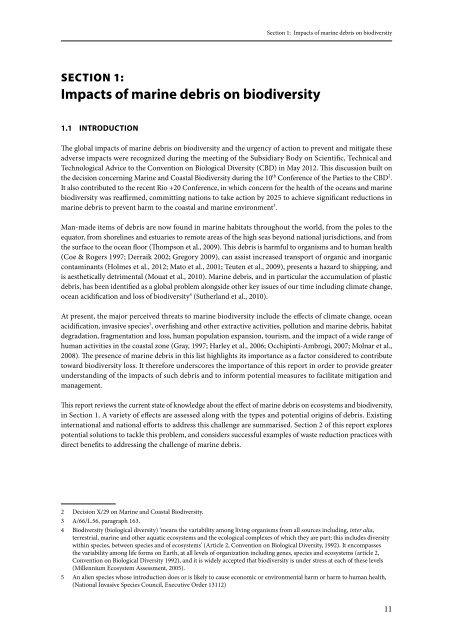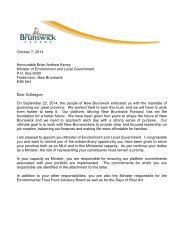cbd-ts-67-en
cbd-ts-67-en
cbd-ts-67-en
- No tags were found...
You also want an ePaper? Increase the reach of your titles
YUMPU automatically turns print PDFs into web optimized ePapers that Google loves.
section 1:<br />
Impac<strong>ts</strong> of marine debris on biodiversity<br />
1.1 INTRODUCTION<br />
Section 1: Impac<strong>ts</strong> of marine debris on biodiversity<br />
The global impac<strong>ts</strong> of marine debris on biodiversity and the urg<strong>en</strong>cy of action to prev<strong>en</strong>t and mitigate these<br />
adverse impac<strong>ts</strong> were recognized during the meeting of the Subsidiary Body on Sci<strong>en</strong>tific, Technical and<br />
Technological Advice to the Conv<strong>en</strong>tion on Biological Diversity (CBD) in May 2012. This discussion built on<br />
the decision concerning Marine and Coastal Biodiversity during the 10 th Confer<strong>en</strong>ce of the Parties to the CBD 2 .<br />
It also contributed to the rec<strong>en</strong>t Rio +20 Confer<strong>en</strong>ce, in which concern for the health of the oceans and marine<br />
biodiversity was reaffirmed, committing nations to take action by 2025 to achieve significant reductions in<br />
marine debris to prev<strong>en</strong>t harm to the coastal and marine <strong>en</strong>vironm<strong>en</strong>t 3 .<br />
Man-made items of debris are now found in marine habita<strong>ts</strong> throughout the world, from the poles to the<br />
equator, from shorelines and estuaries to remote areas of the high seas beyond national jurisdictions, and from<br />
the surface to the ocean floor (Thompson et al., 2009). This debris is harmful to organisms and to human health<br />
(Coe & Rogers 1997; Derraik 2002; Gregory 2009), can assist increased transport of organic and inorganic<br />
contaminan<strong>ts</strong> (Holmes et al., 2012; Mato et al., 2001; Teut<strong>en</strong> et al., 2009), pres<strong>en</strong><strong>ts</strong> a hazard to shipping, and<br />
is aesthetically detrim<strong>en</strong>tal (Mouat et al., 2010). Marine debris, and in particular the accumulation of plastic<br />
debris, has be<strong>en</strong> id<strong>en</strong>tified as a global problem alongside other key issues of our time including climate change,<br />
ocean acidification and loss of biodiversity 4 (Sutherland et al., 2010).<br />
At pres<strong>en</strong>t, the major perceived threa<strong>ts</strong> to marine biodiversity include the effec<strong>ts</strong> of climate change, ocean<br />
acidification, invasive species 5 , overfishing and other extractive activities, pollution and marine debris, habitat<br />
degradation, fragm<strong>en</strong>tation and loss, human population expansion, tourism, and the impact of a wide range of<br />
human activities in the coastal zone (Gray, 1997; Harley et al., 2006; Occhipinti-Ambrogi, 2007; Molnar et al.,<br />
2008). The pres<strong>en</strong>ce of marine debris in this list highligh<strong>ts</strong> i<strong>ts</strong> importance as a factor considered to contribute<br />
toward biodiversity loss. It therefore underscores the importance of this report in order to provide greater<br />
understanding of the impac<strong>ts</strong> of such debris and to inform pot<strong>en</strong>tial measures to facilitate mitigation and<br />
managem<strong>en</strong>t.<br />
This report reviews the curr<strong>en</strong>t state of knowledge about the effect of marine debris on ecosystems and biodiversity,<br />
in Section 1. A variety of effec<strong>ts</strong> are assessed along with the types and pot<strong>en</strong>tial origins of debris. Existing<br />
international and national effor<strong>ts</strong> to address this chall<strong>en</strong>ge are summarised. Section 2 of this report explores<br />
pot<strong>en</strong>tial solutions to tackle this problem, and considers successful examples of waste reduction practices with<br />
direct b<strong>en</strong>efi<strong>ts</strong> to addressing the chall<strong>en</strong>ge of marine debris.<br />
2 Decision X/29 on Marine and Coastal Biodiversity.<br />
3 A/66/L.56, paragraph 163.<br />
4 Biodiversity (biological diversity) ‘means the variability among living organisms from all sources including, inter alia,<br />
terrestrial, marine and other aquatic ecosystems and the ecological complexes of which they are part; this includes diversity<br />
within species, betwe<strong>en</strong> species and of ecosystems’ (Article 2, Conv<strong>en</strong>tion on Biological Diversity, 1992). It <strong>en</strong>compasses<br />
the variability among life forms on Earth, at all levels of organization including g<strong>en</strong>es, species and ecosystems (article 2,<br />
Conv<strong>en</strong>tion on Biological Diversity 1992), and it is widely accepted that biodiversity is under stress at each of these levels<br />
(Mill<strong>en</strong>nium Ecosystem Assessm<strong>en</strong>t, 2005).<br />
5 An ali<strong>en</strong> species whose introduction does or is likely to cause economic or <strong>en</strong>vironm<strong>en</strong>tal harm or harm to human health,<br />
(National Invasive Species Council, Executive Order 13112)<br />
11



